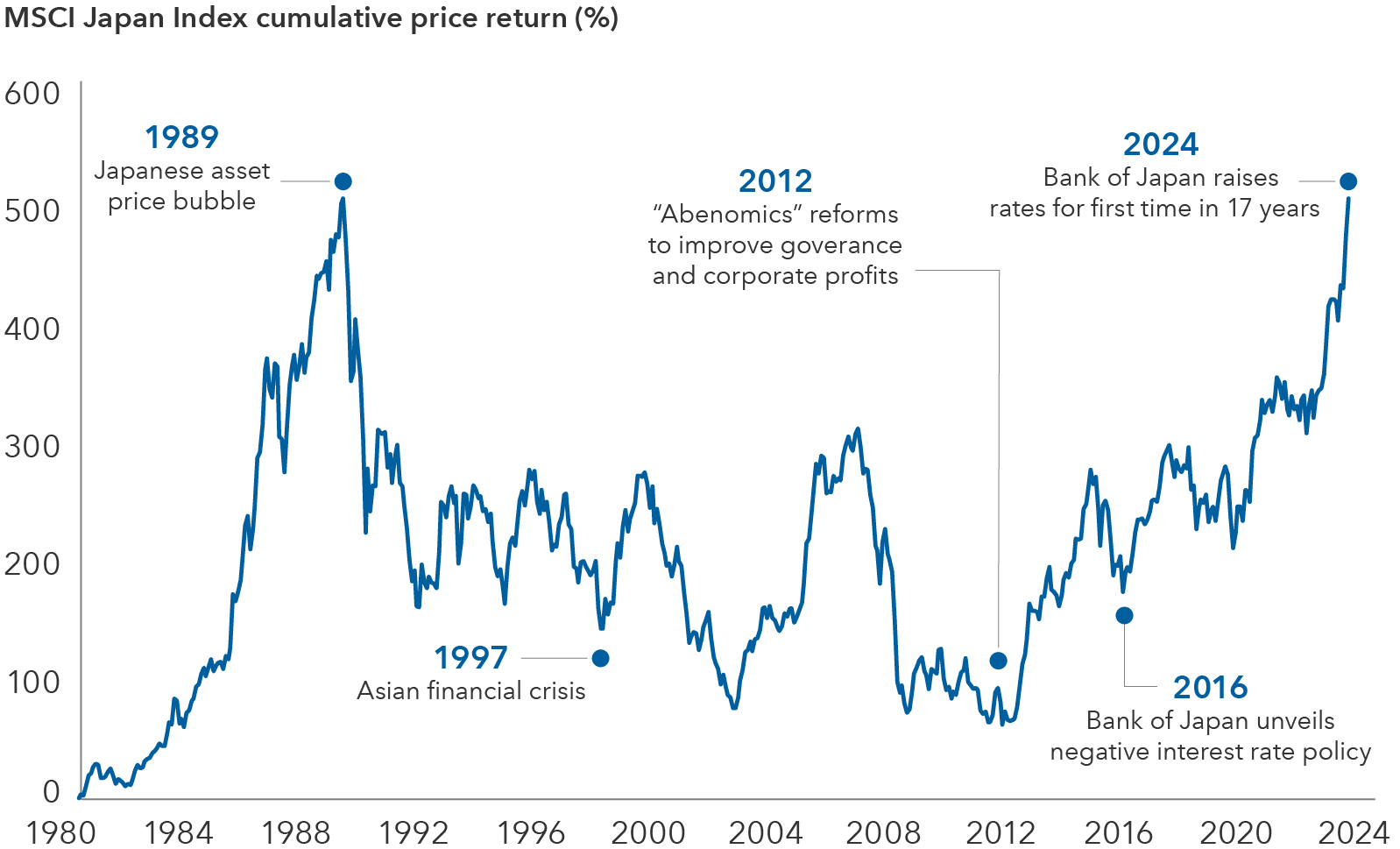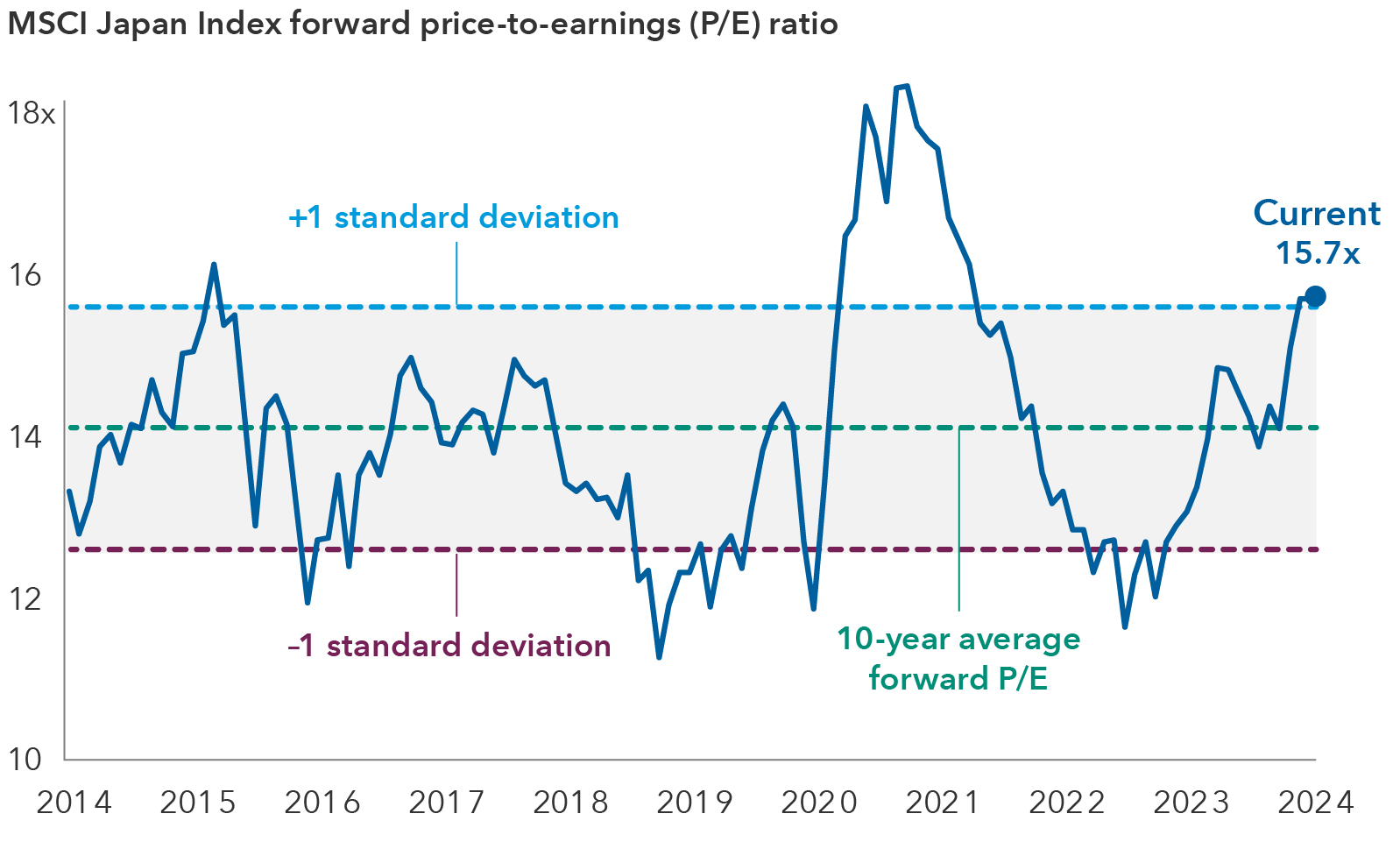Global Equities
Japan
All of a sudden, it's like 1989 in Japan. The MSCI Japan Index has once again climbed to its lofty highs when Japanese companies dominated the business world. Many have asked if this current boom is sustainable, especially after three decades of deflation and disappointing equity returns in the wake of the country's asset price bubble.
We think this time is different. The Bank of Japan scrapped the negative interest rate policy it launched in 2016 and raised rates for the first time in 17 years. Also, impediments to equity returns, present since the 1990s, appear to be receding and could result in Japan's equity market rerating to higher valuations.
Foremost among these is an end to Japan's long spell of deflation. Inflation has held at or above 2% since April 2022. Productivity growth is poised to rise, which along with sustained inflation, could boost corporate earnings growth. Meanwhile, the ongoing push by regulators to improve corporate governance and encourage consolidation through mergers and acquisitions could raise profitability at many companies, which would allow for better capital allocation and help boost dividends. Furthermore, a shrinking population is causing chronic labour shortages, forcing companies to seek efficiencies.
The sun rises again: Japanese stocks surge to 1989 levels

Sources: Capital Group, MSCI, RIMES. Cumulative price returns shown from December 31, 1980, to February 29, 2024. Returns shown in Japanese yen. The cumulative return is the total change in the investment price over a set time. Past results are not predictive of results in future periods.
Inflation and rising rates could lift long-suppressed valuations
Despite the rally in Japanese stocks, valuations appear reasonable at 16 times forward earnings for the next 12 months (as of March 19, 2024). The market's forward price-to-earnings (P/E) has been range-bound for many years, held down by prolonged deflation and low interest rates, as well as subpar capital allocation and corporate governance.
In a deflationary economy, the traditional discount rate relationship between interest rates and P/E ratios seems to invert. This dynamic has most likely inhibited market valuations from rising much above 17 times earnings during the past 10 years. Longer term, it’s plausible to imagine interest rates rising to 2%, thanks to higher productivity growth and inflation, which would open the possibility of the market P/E rising to 20–25 times over time.
Valuations for Japanese equities have been range-bound

Source: FactSet. Data as of March 19, 2024.
What could drive domestic productivity and earnings growth?
1. Digital overhaul: A digital transformation (including AI) is happening across the economy from payment systems to back-office operations. Banks like Resona, for example, plan to automate 10,000 jobs. Japan's digital revamp can provide solutions to labour shortages and free workers to move to higher value-added jobs.
2. Erosion of lifetime employment: More top graduates are opting out of traditional employment, choosing to work in consulting, at startups or launching their own businesses. Younger workers are also changing jobs after three years. A younger generation is showing greater entrepreneurship and is looking for opportunities in new economy companies rather than the old guard companies.
3. Service sector consolidation: The median age of small- and medium-sized business owners is 67. A large fraction of these firms could shutter or be bought by more profitable companies over the next five to 10 years. This could boost productivity, especially in the service sector which traditionally has been half as productive as manufacturing.
4. Corporate efficiency: The five-year average for returns on equity (ROE) for TOPIX 500 Index companies was 8% as of December 31, 2023. That's a stark contrast to 12% in Europe (STOXX 600 Index) and 17% in the U.S. (S&P 500 Index). The broad push by Japanese regulators and foreign hedge funds to increase ROE across Japan's corporate sector could raise earnings growth materially.
A more attractive place to invest
Japanese firms have developed unique technologies in niche markets, building durable businesses with highly defensible moats. They are also positioned to capitalize on global supply chain shifts amid heightened geopolitical tensions as companies and countries seek multiple sources for supplies.
For instance, a powerhouse in semiconductor manufacturing in the 1980s and '90s, Japan is seeing renewed interest from multinational companies in the industry. TSMC, Micron Technology, and Samsung Electronics are building new chipmaking plants in the country given Japan's skilled and specialized talent pool. These investments could be a tailwind for Japanese firms such as SMC, a specialized components maker for semiconductor production; Shin-Etsu, the world’s largest maker of silicon wafers; and Tokyo Electron, the country's largest chip-equipment manufacturer.
Elsewhere, Japanese information technology (IT) service companies will likely continue to be beneficiaries of increased spending. Japan is playing catch-up moving into the digital age. There is a shortage of engineers, and an aging workforce means employee productivity needs to improve. Rising demand is empowering IT service providers to obtain more favourable pricing terms that should help profit margins.
While long reluctant to do so, Japanese companies have also been raising prices, ranging from Disneyland operator Oriental Land to snacks maker Kotobuki Spirits to heavy equipment manufacturer Komatsu. This could support margins.
Other companies are reinventing themselves, presenting attractive investment opportunities. For example, pharmaceuticals firm Daiichi-Sankyo, once hampered by a portfolio of undifferentiated drugs, has a promising pipeline of novel cancer treatments.
The country's small- to mid-cap sector is another hunting ground. The small-cap market is less covered by sell-side brokerage houses, giving active investors the option to invest in less known — or misunderstood — companies.
Collectively, many of these positive developments are making Japan a more attractive place to invest. At its peak in the late 1980s, Japan represented more than 40% of the MSCI World Index. Today, it accounts for 6%. Its role in global equities should expand amid increasing interest from investors.
Eu-Gene Cheah is a portfolio manager for Capital Group International Equity Fund (Canada).
The MSCI Japan Index is designed to measure the performance of the large- and mid-cap segments of the Japanese market.
S&P 500 Index is a market-capitalization-weighted index based on the results of 500 widely held common stocks.
The STOXX 600 Index represents large-, mid- and small-capitalization companies across 17 countries of the European region: Austria, Belgium, Denmark, Finland, France, Germany, Ireland, Italy, Luxembourg, the Netherlands, Norway, Poland, Portugal, Spain, Sweden, Switzerland and the United Kingdom.
TOPIX 500 Index is a market capitalization-weighted index consisting of the 500 largest and most liquid components of the Tokyo Stock Price Index (TOPIX).
Forward price-to-earnings ratio reflects the current share price relative to the consensus estimate for earnings per share on a 12-month forward basis.
Our latest insights
-
-
Artificial Intelligence
-
Technology & Innovation
-
Demographics & Culture
-
RELATED INSIGHTS
-
-
Demographics & Culture
-
Commissions, trailing commissions, management fees and expenses all may be associated with mutual fund investments. Please read the prospectus before investing. Mutual funds are not guaranteed, their values change frequently and past performance may not be repeated.
Unless otherwise indicated, the investment professionals featured do not manage Capital Group‘s Canadian mutual funds.
References to particular companies or securities, if any, are included for informational or illustrative purposes only and should not be considered as an endorsement by Capital Group. Views expressed regarding a particular company, security, industry or market sector should not be considered an indication of trading intent of any investment funds or current holdings of any investment funds. These views should not be considered as investment advice nor should they be considered a recommendation to buy or sell.
Statements attributed to an individual represent the opinions of that individual as of the date published and do not necessarily reflect the opinions of Capital Group or its affiliates. This information is intended to highlight issues and not be comprehensive or to provide advice. For informational purposes only; not intended to provide tax, legal or financial advice. We assume no liability for any inaccurate, delayed or incomplete information, nor for any actions taken in reliance thereon. The information contained herein has been supplied without verification by us and may be subject to change. Capital Group funds are available in Canada through registered dealers. For more information, please consult your financial and tax advisors for your individual situation.
Forward-looking statements are not guarantees of future performance, and actual events and results could differ materially from those expressed or implied in any forward-looking statements made herein. We encourage you to consider these and other factors carefully before making any investment decisions and we urge you to avoid placing undue reliance on forward-looking statements.
The S&P 500 Composite Index (“Index”) is a product of S&P Dow Jones Indices LLC and/or its affiliates and has been licensed for use by Capital Group. Copyright © 2024 S&P Dow Jones Indices LLC, a division of S&P Global, and/or its affiliates. All rights reserved. Redistribution or reproduction in whole or in part are prohibited without written permission of S&P Dow Jones Indices LLC.
FTSE source: London Stock Exchange Group plc and its group undertakings (collectively, the "LSE Group"). © LSE Group 2024. FTSE Russell is a trading name of certain of the LSE Group companies. "FTSE®" is a trade mark of the relevant LSE Group companies and is used by any other LSE Group company under licence. All rights in the FTSE Russell indices or data vest in the relevant LSE Group company which owns the index or the data. Neither LSE Group nor its licensors accept any liability for any errors or omissions in the indices or data and no party may rely on any indices or data contained in this communication. No further distribution of data from the LSE Group is permitted without the relevant LSE Group company's express written consent. The LSE Group does not promote, sponsor or endorse the content of this communication. The index is unmanaged and cannot be invested in directly.
BLOOMBERG® is a trademark and service mark of Bloomberg Finance L.P. and its affiliates (collectively “Bloomberg”). Bloomberg or Bloomberg’s licensors own all proprietary rights in the Bloomberg Indices. Neither Bloomberg nor Bloomberg’s licensors approves or endorses this material, or guarantees the accuracy or completeness of any information herein, or makes any warranty, express or implied, as to the results to be obtained therefrom and, to the maximum extent allowed by law, neither shall have any liability or responsibility for injury or damages arising in connection therewith.
MSCI does not approve, review or produce reports published on this site, makes no express or implied warranties or representations and is not liable whatsoever for any data represented. You may not redistribute MSCI data or use it as a basis for other indices or investment products.
Capital believes the software and information from FactSet to be reliable. However, Capital cannot be responsible for inaccuracies, incomplete information or updating of the information furnished by FactSet. The information provided in this report is meant to give you an approximate account of the fund/manager's characteristics for the specified date. This information is not indicative of future Capital investment decisions and is not used as part of our investment decision-making process.
Indices are unmanaged and cannot be invested in directly. Returns represent past performance, are not a guarantee of future performance, and are not indicative of any specific investment.
All Capital Group trademarks are owned by The Capital Group Companies, Inc. or an affiliated company in Canada, the U.S. and other countries. All other company names mentioned are the property of their respective companies.
Capital Group funds are offered in Canada by Capital International Asset Management (Canada), Inc., part of Capital Group, a global investment management firm originating in Los Angeles, California in 1931. Capital Group manages equity assets through three investment groups. These groups make investment and proxy voting decisions independently. Fixed income investment professionals provide fixed income research and investment management across the Capital organization; however, for securities with equity characteristics, they act solely on behalf of one of the three equity investment groups.
The Capital Group funds offered on this website are available only to Canadian residents.
 Anne Vandenabeele
Anne Vandenabeele
 Eu-Gene Cheah
Eu-Gene Cheah
 Steve Caruthers
Steve Caruthers